




Discover the thrill at Mammoth Bike Park, the premier bike park in the U.S. With over 80 miles of trails for all skill levels, breathtaking views, and adrenalinepumping descents, it’s the ultimate summer adventure. Gear up and ride into an unforgettable experience.













PUBLISHER
Cathy Claesson cathy@adventuresportsjournal.com
EDITOR-IN-CHIEF
Matt Niswonger matt@adventuresportsjournal.com
COPY EDITORS
Michele Lamelin & Jennifer Stein
CONTRIBUTING EDITORS
Leonie Sherman, Matt Johanson, Anthea Raymond, Kurt Gensheimer, Krista Houghton, James Murren
CONTRIBUTING PHOTOGRAPHERS
Dick Sunderland, Esther Feldman, Bruce Raley, StanislausRiver.org, David Kay, Sierra Mac River Trips, Tim Palmer, Bob Goodall, Leonie Sherman, Krista Houghton, Discover Siskiyou, Matt Johanson, GP Martin, Ryan Salm, Matt Chappell, Miguel Blanco, Tyler Fox, Ocean Gardener, Mike Borchard, Talisa Lanoe
COVER DESIGN
Lauren Worth
INDUSTRY NEWS & SOCIAL MEDIA
Ella Suring news@adventuresportsjournal.com
EVENTS MARKETING & DISTRIBUTION
Krista Houghton & Lee Houghton events@adventuresportsjournal.com
ADVERTISING
ACCOUNT EXECUTIVE
Cathy Claesson I 831.234.0351 cathy@adventuresportsjournal.com
DESTINATION MARKETING MANAGER
Pamela Coffey I 619.887.9937 pamela@adventuresportsjournal.com
Our office resides in Aulinta (‘place of the Red Abalone’) in the larger region called Popeloutchom (‘paradise’) by the Amah Mutsun Tribe.
ADVENTURE SPORTS JOURNAL PO BOX 35, Santa Cruz, CA 95063 staff@adventuresportsjournal.com
Opinions expressed are those of the authors and not necessarily those of Adventure Sports Journal or our advertisers. We usually agree with our articles, but sometimes we don’t. We welcome all contributions.
All content © Adventure Sports Journal 2024. No part of this publication may be reproduced without permission of the editors.
PROUD MEMBER

How are you going to stop summer from slipping through your fingers?




I will celebrate the long days by hiking, biking, paddling, swimming, climbing, camping and generally squeezing every last drop of joy out of every last day.
I’ve got plans and permits for the John Muir Trail and several 14ers. I’m going to make the most of the summer outdoors with family and friends.
Here in SoCal June Gloom always gets us off to a slow start. I’m sitting down with my calendar and making July, August, and September plans to make up for that.
By making sure my calendar is always brimming with radical adventures and good friends.

Summer is short, but the days are long. I’m going to make sure to enjoy more sunsets, whether it’s from the mountain tops or the beach. Sitting quietly soaking in each and every day.

Summer will slip through my fingers in the form of water: salt and fresh. Bodysurfing, kayaking, SUPing, snorkeling, and swimming here in San Diego and in the Sierra, are on the summer agenda.


I’m going to hike and climb in Yosemite. I want to reconnect with Yosemite climbing friends and do some adventure writing. I’m going to meditate as much as possible and savor every moment of summer.
I have a lot of trail races on the books for the summer. I also have plans to spend time with friends, and will be adventuring around California in a van.








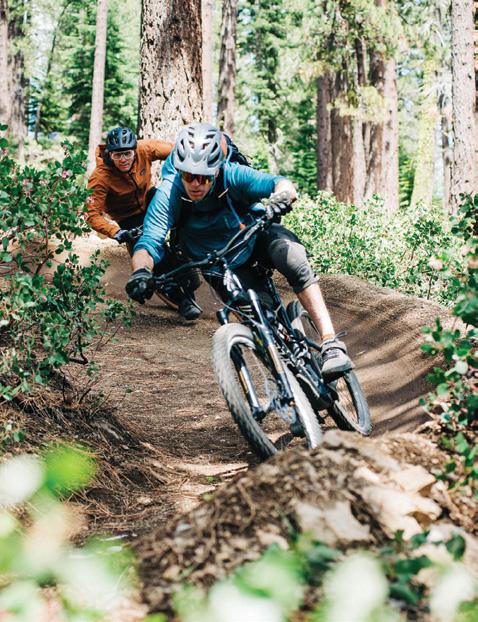


SeaTrees ambassador, Ecoboard shaper, musician and spreader of stoke, Ashley Lloyd is a beacon of light whenever she hits the water.
Photo: Bryan “Wetfeet” Garrison


Explore beautiful Yosemite Mariposa County and float down the Merced River, where every route is the scenic route. Rise to the challenge of whitewater rafting trips, or let gentle currents carry you to new vistas. At the end of the day, head back to your home away from home in cozy cabins or upscale resorts in Mariposa County.
Scan to plan your trip
Welcome to issue #133. Summer is here and we hope you are enjoying it. As this issue comes together, we have spent the last few days at the Outdoor Retailer trade show in Salt Lake City. The gathering is one of the major trade shows for the outdoor industry, drawing enthusiasts and professionals from across the country. Despite our diverse backgrounds, we are united by a shared love for the great outdoors — a common thread that binds us all.
After the hustle and bustle of the trade show, Cathy and I returned to our hotel room, feeling the fatigue from a day filled with conversations and connections. We turned in early, knowing that an early start awaited us.
The next morning, I woke up and began my daily meditation practice, something I’ve been committed to for the past few years. As I’ve shared in previous issues, meditation has become a cornerstone of my routine, helping to balance my mood, enhance
my writing, and increase my overall happiness.
As often happens while meditating my mind wanders and I think about the show and what draws us to the outdoor lifestyle. I have an insight. We go outside to find relief from our own minds. The constant chatter of our inner monologue can be relentless and exhausting. Somehow we know instinctively that nature has the power to heal us. It provides a sense of inner peace by allowing us to cultivate “inner space.”
The constant chatter of our inner monologue can be relentless and exhausting. Somehow we know instinctively that nature has the power to heal us.
Inner space is a mental state free from the noise of worry, anger, and insecurity. We can nurture this space through outdoor activities, exercise, meditation, and yoga.
It’s uncomfortable to discuss, but the world is sick because many of us are mentally unwell. We feel trapped in our minds, struggling with our egos, and desperately seeking escape from our mental confines.
Ironically our digital devices have made the problem worse, not better. Designed as a way to stay better connected, social media platforms have been driving us apart as we spend hours per day hunched over our smartphones.
For me, a combination of meditation
and nature therapy offers a solution to this personal and collective problem. These practices help me treat myself and others with compassion. While I still have a long way to go, I believe I have discovered a path to liberation — a path that involves daily doses of nature and meditation to create inner space. I take solace in the words of the philosopher Eckhart Tolle. In his book The Power of Now he writes, “The secret of life is to ‘die before you die’ — and find that there is no death.”
The “death” he is promoting is a letting go of the egoic mind. Until we realize that strictly individual consciousness is an unfortunate and painful illusion, our collective and individual woes will continue. We must connect with nature to experience our truest selves.
A quiet mind is a blessing. That’s what I want for you. That’s what I want for myself. We hope reading this issue of ASJ inspires you to reconnect with nature, your truest self.
Thanks for reading my words. I hope you discover the beauty of nature this summer in a way that inspires and heals you. Start with a quiet mind and everything will flow smoothly after that.
We hope you enjoy the issue and embrace the outdoors!
MattNiswonger matt@adventuresportsjournal.com
Adventure Sports Journal depends on the support of our advertisers and people like you.
ASJ is an important voice for the outdoor community in California, and we are in direct competition with corporate media and online platforms.
Please consider helping us continue our work by becoming a member today.
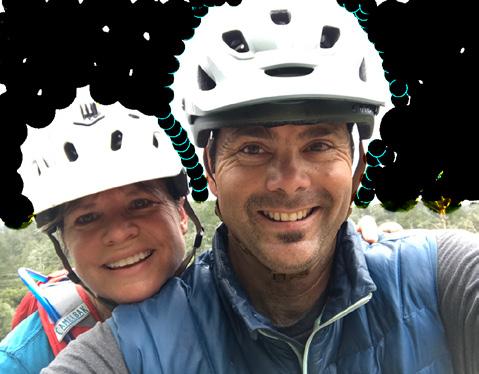
With your support we can continue to inspire adventure, event participation, exploration and environmental stewardship. — Matt Niswonger & Cathy Claesson





Sierra Buttes Trail Stewardship (SBTS) is hosting the Mountains to Meadows Trailfest, a four-day outdoor festival from September 19-22, 2024, at Plumas-Sierra County Fairgrounds. This celebration features two days of trailwork with the SBTS Pro Trail Crew on Mount Hough, a Poker Run/Ride, locally led hikes, trail runs, mountain bike and moto rides, family and late-night rollerskating, food trucks, a beverage garden, and live music headlined by The Scott Pemberton Band, Boot Juice, and The Gold Souls. Festival passes range from $50 to $699, with proceeds supporting SBTS’s Connected Communities project to link 15 mountain towns via a 564-mile trail. Kids under 17 enter free, with passes including tent camping for the weekend.Connected Communities aims to revitalize mountain towns in the Lost Sierra by fostering recreation-based economies. mountains-to-meadows.adventuresportsjournal.com
California’s newest state park, Dos Rios, opened to the public on June 12. Located eight miles west of Modesto, Dos Rios spans 1,600 acres and is the largest publicprivate floodplain restoration project in the state, aimed at restoring habitat for threatened wildlife at the Tuolumne and San Joaquin Rivers. The opening event, attended by over 200 people including state and local leaders, coincided with the Third Annual California State Parks Week. Visitors enjoyed park tours, mural painting, and learned about the future of Dos Rios. Activities currently include hiking, picnicking, bird watching, and engaging with park interpreters. Future plans involve river access for swimming, angling, and boating, as well as trails for biking and other outdoor activities. dosrios.adventuresportsjournal.com
Safe and reliable water is crucial in Death Valley National Park, one of the hottest places on Earth. The Great American Outdoors Act (GAOA) Legacy Restoration Fund is providing approximately $62 million for essential upgrades to the park’s water and wastewater infrastructure. This project addresses deferred maintenance, repairs environmental hazards, and enhances conservation efforts. Upgrades include replacing over 12 miles of aging pipes, constructing a new well, and building new water treatment facilities. These improvements will create looped water systems to prevent service interruptions and reduce untreated sewage leaks. Environmental assessments for the project are complete. gaoa-dv-62. adventuresportsjournal.com

On June 10, the California Department of Fish and Wildlife (CDFW) and the California State University Maritime Academy (Cal Maritime) released approximately one million fall-run Chinook salmon smolts from the Cal Maritime campus in Vallejo. This marked the first release of Chinook salmon from this location in almost four decades and one of the final releases of hatchery fallrun Chinook salmon in San Francisco and San Pablo Bays this season. “Partnerships like the one with Cal Maritime are crucial for rebuilding fallrun Chinook salmon populations,” said CDFW Senior Environmental Scientist Jason Julienne. salmon-cal-maritime. adventuresportsjournal.com
The 2024 Outdoor Participation Trends Report, produced by the Outdoor Foundation (OF) and Outdoor Industry Association (OIA), reveals significant insights into US outdoor recreation. Participation grew by 4.1% in 2023, totaling 175.8 million participants, or 57.3% of the US population. This growth was widespread, drawing in new casual participants across activities like hiking, biking, camping, running, and fishing. Key highlights include a 22.2 million increase in participants since 2019, with over half of American women now engaging in outdoor activities. The LGBTQ+ community showed the highest activity levels among adults. While the participant base became more diverse, the majority remains white (69.7%), with Black (10.3%), Hispanic (13.4%), Asian or Pacific Islander (5.3%), and other ethnicities making up the rest. On average, participants logged 62.5 outings in 2023, down slightly from the previous year. Additionally, 7.7 million Americans tried outdoor activities for the first time. 2023-OIA-report. adventuresportsjournal.com


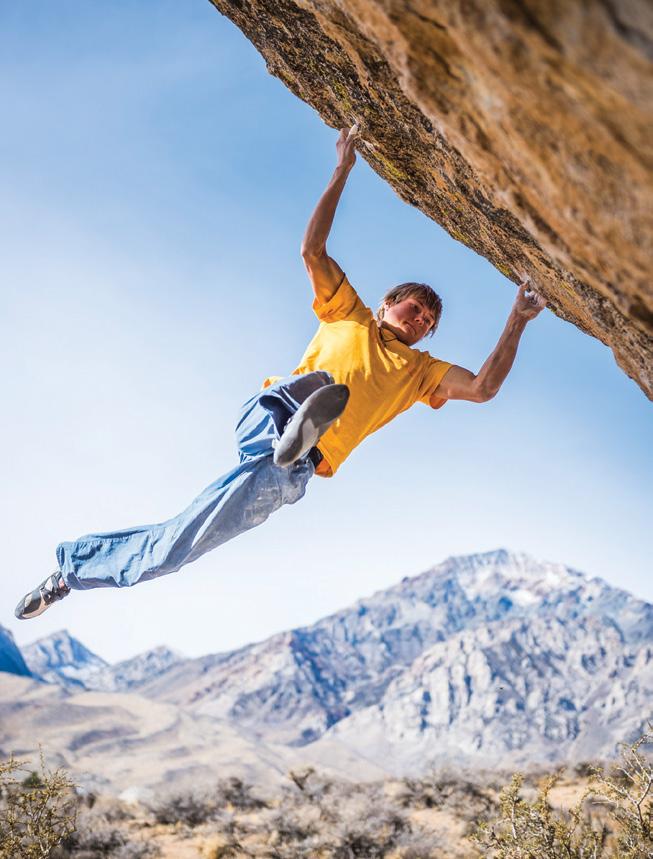

If you have ever felt the impossibility of pursuing a passion after a significant life change, you are not alone. Hand Holds: Climbing After Parenthood is a free web series that explores how pro climbers continue their passion post-kids. Viewers can tune in for candid conversations with Beth Rodden, Majka Burhardt, Eddie and Anna Taylor, and Jon and Jess Glassberg, among others. Directed by Allyson Gunsallus, who became a parent in 2021, the series discusses postpartum recovery, childcare, and climbing logistics. With an award-winning crew, the series is launching a crowdfund campaign to offset costs. The first episode is set for Spring 2025. hand-holds. adventuresportsjournal.com
Achieve Tahoe secures a gamechanging $50,000 grant from The Hartford to expand their adaptive sports equipment inventory. This funding will enable more individuals with disabilities to participate in skiing, snowboarding, and other outdoor activities, fostering inclusivity in sports. The partnership underscores The Hartford’s commitment to enhancing community well-being through adaptive recreation. This investment not only empowers Achieve Tahoe to broaden their impact but also signifies a significant stride towards a more accessible outdoor sports environment. achieve-tahoe. adventuresportsjournal.com
California’s Fish and Game Commission unanimously approved the white sturgeon as a candidate for protection under state law. This designation triggers a review by the Department of Fish and Wildlife to assess whether the species faces sufficient threats to potentially be listed as threatened or endangered, a process expected to take about a year. In the meantime, the white sturgeon will be protected under the California Endangered Species Act until a final decision is made. This decision highlights California’s dedication to biodiversity conservation and sustainable management of aquatic resources, aiming to preserve the white sturgeon’s habitat and ensure its longterm survival in state waters whitesturgeon.adventuresportsjournal.com
Join the Death Ride – Tour of the California Alps for a challenging 103mile road cycling event with over 14,000 feet of climbing across Monitor Pass, Ebbetts Pass, and Pacific Grade. Nearly 90% of the course is closed to vehicles, ensuring a safe ride, fully supported with aid stations, a lunch stop, SAG vehicles, and medical support. Enjoy the vendor-filled cycling expo at Turtle Rock Park featuring bike shops, local artists, and Native American food, with beverages from Sierra Nevada Brewing. Finishers praise the ride for its challenge and providing a sense of accomplishment. Highway 89 and Highway 4 will be closed on July 13. dr20241.adventuresportsjournal.com
The Mammoth TUFF is a premier gravel cycling event scheduled for September 13-15, in Mammoth Lakes. Participants can choose from routes up to 100 miles, featuring challenging gravel trails and scenic views of the Sierra Nevada. The event fosters a community atmosphere with additional activities like the Mammoth BUFF Beer Run. tuff.adventuresportsjournal.com
Ride the Rim Oregon is scheduled for September 7 and 14, at Crater Lake National Park. The event features two vehicle-free days — allowing participants to ride, run, or walk along the East Rim Drive, while taking in the stunning views of Crater Lake’s pristine waters and old-growth forests. ridethe-rim.adventuresportsjournal.com
The 8th Annual Race the Rails event in Ely, Nevada, is scheduled for September 7. Participants race historic steam engines of the Nevada Northern Railway on either a 10-mile mountain biking course or a 25-mile road biking course. The event, which includes early registration and race day options, supports the Great Basin Trails Alliance, funding local trail systems. Riders start at 9am, aiming to beat the train back to the depot. Registration includes a tech T-shirt, finisher medal, train voucher, and meal ticket. racethe-rails.adventuresportsjournal.com


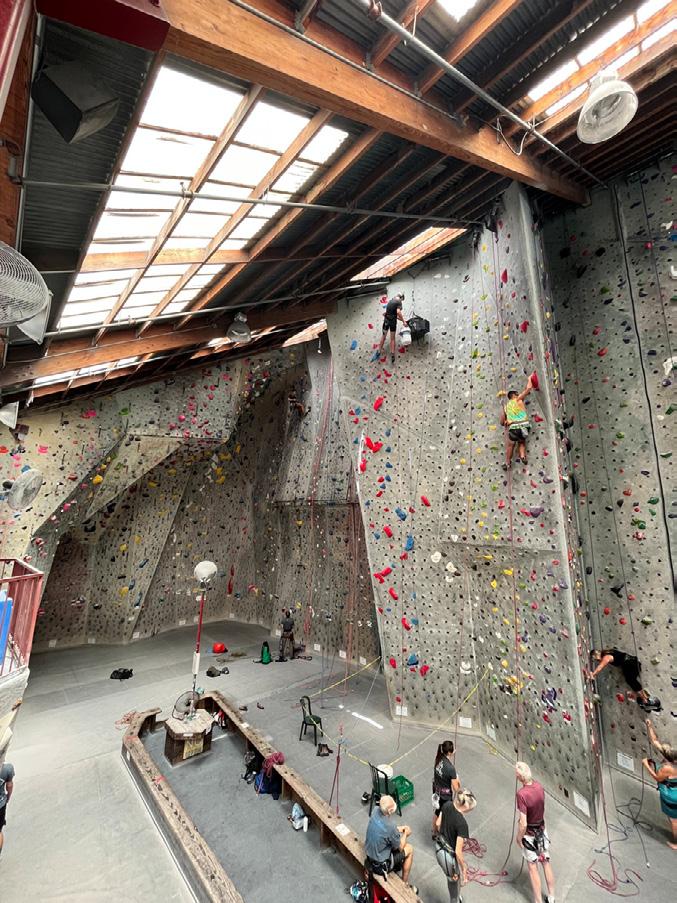



Santa Barbara Adventures
By James Murren

When traveling, meeting up with locals can make things flow more smoothly. Having experienced guides to lead me through Santa Barbara’s outdoor adventures made all the difference on this trip.
On a somewhat blustery morning at Haskell’s Beach, our kayaking guide Chani’s infectious positive energy and beaming smile set the vibe; no matter the conditions, we were going to have fun. Paddling away from shore, it was clear that the current was pulling hard to the north. We paddled south, the idea being that the way back would be a cruise. Out on the water, we became Chani’s students, her environmental education lessons reminding us of the importance of sea kelp, among other things. When she welcomed us to a spa session, putting kelp on her face and forehead, I laughed out loud and told myself that a quality guide can make all the difference when exploring new places. sbadventureco.com
After lunch, I met up with Sergio from Cal Coast Adventures to get in a mountain biking outing. Again, the positive energy was flying high. A ball of energy and a cyclist with tight sinew, I knew I was in for it with him. We climbed some thousand feet of elevation up the road to drop in on West Fork Trail. The singletrack descent was swoopy here, with several tight turns there. Rock gardens on the lower end were a blast, if you like chunk and trying to clean technical sections of trail. At one point, Sergio goofed one, went back, and then rode it clean through, the afternoon session of a trail segment reminding me that the attitude of yesterday is still alive today. calcoastadventures.com


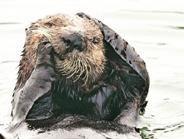

Night Lizard Brewing Company on State Street is a brewery like few others. From what I heard, their ethos is entirely about environmental education, a brewery/tasting room serving as the gathering space for teaching and advocacy around protecting the unique natural resources of the Central Coast. The family-owned and operated indie brewery has a relaxing and super welcoming atmosphere, making it a friendly place to hang out. The beer? Each one is named after an endangered species from the Central
Coast of California – Gnatcatcher IPA was a pleaser, but the Live Forever DIPA was the standout. nightlizardbrewingcompany.com

Still on State Street, there is M Special Brewing Company. I spotted the saison and immediately ordered it. A Farmhouse Ale, All Time Saison is exactly what you would expect, if you understand that saisons have no specific tasting profile. It had the spice and the hay mow in there, making this farmer’s son feel right at home. If lighter beer with a fruit presence hanging out in the mix is what you like, Sabado Tarde is what you are looking for, no doubt. It’s a tangerine ale that tastes like a perfect sunny day spent kayaking in the morning and mountain biking in the afternoon. mspecialbrewco.com

Captain Fatty’s Mambo Hazy DIPA is a citrus gusher. captainfattys.com
Validation Ale’s concept at their brewery/tasting room is intriguing. What’s on the board is constantly changing, based on what the voters say. Voters? Yep. validationale.com
Brass Bear Brewing and Bistro in the Funkzone is another spot to get a taste of Santa Barbara’s brewing scene. The patio out back was casual and the the Goldilocks Blonde Ale went down easy. brassbearbrewing.com















T-Shirt

100% recycled T-shirts using Recover brand fabrics available online.


TrailShirtsBuilding

Women's T-shirts Available Scan



By Matt Johanson

A long tunnel of sharp lava stalagmites stretched out just a few feet beneath a low ceiling of jagged stalactites. Flashlights spotted no end to the cave’s passage, but a map showed they were on course. So three young men crawled further into the darkness, a few painful inches at a time.
Lava Beds National Monument, located in Siskiyou County near the California-Oregon border, protects 46,000 acres and some 900 caves formed by volcanic activity.
Delving deep into rarely visited wilderness caves excites the most adventurous visitors, but one need not embrace dark and rocky suffering to experience spelunking here. Visitors can walk freely through any number of easily accessible caverns, enjoying the rock formations and cool air. The monument’s open access is sure to delight anyone who’s ever taken an expensive underground tour on private property and longed for a more independent experience.
First-time visitors to Lava Beds can fill several days exploring the attractions of Cave Loop Road. The ultra-easy Mushpot Cave has lights and interpretive signs explaining its formations, and is the most suitable for families with children. Other less challenging outings include Sentinel, Valentine and Skull caves. Each has large open passages with high ceilings and relatively smooth floors. Exploring most developed caves
requires no special skill or experience, but buying a map book from the visitor center will help you find your way through the longer passages.
Blue Grotto, Sunshine, and Balcony caves offer moderately challenging excursions which may involve brief stooping and rocky footing but no prolonged crawling.
The monument’s caves date back up to 40,000 years, when volcanic activity created lava tubes, which cooled and drained to create tunnels of rock known as lava beds. Spelunkers can see a variety of interesting features such as collapsed roofs, year-round ice, and Modoc pictographs.
Native history adds more appeal for non-spelunking visitors. Petroglyph Point, a hill of volcanic tuff, attracted Indigenous people who created more than 5,000 carvings over millennia. Modocs believe that Kamookumpts, the creator of the world, sleeps here. A short walk reveals one of the largest concentrations of Native rock art in North America.
Another point of interest is nearby Captain Jack’s Stronghold, a maze of rocky trenches that hosted the Modoc
War in 1872-1873. Visitors can hike through the Modoc position from which the Natives held off a US Army force 20 times their size for five months. Ultimately the Army forced the Modocs to leave their home for a reservation in Oklahoma and executed their principal headman Kientpoos (Captain Jack) and three others.
But spelunking is Lava Beds’ primary draw. If the monument’s warm-up caves leave you wanting more, then consider Thunderbolt, Labyrinth and especially Catacombs. These caves present greater challenges, requiring extensive crawling and above-average physical fitness.
Those who attempt them should come prepared. The National Park Service lends flashlights for free, but bring backups. If you get trapped below the surface without light, nothing short of a rescue will get you out again. Buy a map book.
Wear helmets, long shirts and pants. No matter how hot it gets outside, beneath the surface you’ll be cool, if not chilly. Gloves and knee pads will reduce the pain and misery of crawling across sharp lava. Tunnels range from vast to barely


passable. Some passages are so small that squeezing through them feels like reenacting your own birth.
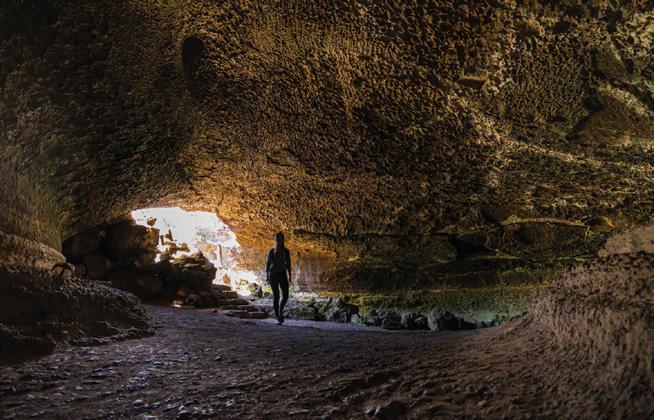


Opposite page, top to bottom: Looking down from the entrance of a lava tube (Discover Siskiyou); Lava Beds National Monument in northern California features an extensive network of lava tube caves and dramatic volcanic landscapes (Discover Siskiyou); Golden Dome Cave deserves its name, as the author discovered (Matt Johanson). This page, clockwise from left: At the monument you will find a wide variety of caves from family friendly to expert (Discover Siskiyou); Captain Jack’s Stronghold is the site of the last stand of the Modoc in 1872-1873 (Discover Siskiyou); A good flashlight is essential for cave exploration. Flashlights are loaned to visitors upon request but you should consider bringing your own (Discover Siskiyou).
The three youngsters mentioned earlier spent most of a day touring Catacombs, the monument’s longest cave at 6,900 feet. A favorite of Lava Beds pioneer Judson Howard, Catacombs features some of the monument’s finest examples of lava flowstone, stalactites, and ribs. More memorable to the youths was the laughter and camaraderie of shared suffering. Hours later, they emerged lightly bruised but proud from the most difficult cave adventure any of them had attempted.
Recently I enjoyed that memory when I returned to Lava Beds 30 years later. Now in my 50s, I’m active in outdoor pursuits but crawling across sharp rocks no longer intrigues me. However, I still enjoyed visiting, and revisiting, several of the caves.
In particular, Golden Dome Cave afforded me a rewarding excursion. I marveled at its ceiling’s brilliant color which inspired the name, and watched with quiet amusement as a young boy
and girl eagerly squeezed through a narrow passage.
With new appreciation, I hiked again through Captain Jack’s Stronghold; I feel the monument should use his real name, Kientpoos. Petroglyph Point, which did not interest me previously, showed me a window to a people and the past.
While I’ve changed considerably in three decades, I was glad to see that Lava Beds has not. This land of history
The monument’s caves date back up to 40,000 years, when volcanic activity created lava tubes, which cooled and drained to create tunnels of rock known as lava beds.
and underground adventure deserves a visit.

Permits: The monument requires visitors to obtain a free permit at the visitor center before entering caves.
Lodging: Within the monument, Indian Wells Campground offers 43 sites on a first-come, first-served basis. Nearby Tulelake offers other lodging. Food: There are no food services within the monument, so come prepared. The nearest stores and restaurants are in Tulelake, about a half-hour drive.
For more info visit nps.gov/labe, or call (530) 667-8100



Story by Krista Houghtnn
As summer approaches, the allure of packing the car and heading up north beckons. Oregon’s longer daylight hours, stunning natural landscapes, and abundance of outdoor activities make it the perfect area for adventure camping.
For those interested in overlanding, the Klamath Falls to Bend segment of The Great American Outback Trail (GAOT) offers a great four-day adventure. This journey takes travelers through remarkable terrain — unveiling the natural wonders of this untamed region — and is perfect for the whole family and furry friends alike. The route is about 175 miles, but plan for 200 miles. There are no gas stations on the route. Always carry extra fuel and depart with a full tank of gas. I strongly recommend downloading the GPX file for the Oregon segment of the GAOT on your phone and using a mapping app, like Gaia GPS to navigate. It will make your trip not only safer, but more enjoyable.
Day 1:
Klamath Falls and Klamath National Wildlife Refuge
This adventure kicks off in the charming city of Klamath Falls. This is the spot to load up on food, water and all the things you will need over the next three nights. Klamath Falls has a great Farmers Market every Saturday from 9-1 on Main Street. We stocked up on local bread, meat and cheeses that were delicious. From here, you will leave the urban hustle and head out into Oregon’s less traveled roads and trails.
Passing the magnificent Upper Klamath Lake, take a moment to soak up the incredible view before you head into the vast region of the Klamath National Wildlife Refuge. On your drive be prepared to see lots of wildlife, as the area is teeming with

1 2
a plethora of bird species that wade in the shallow waters. Stop in at the Visitor Center and they will guide you to the many trails available. Pack your long shirt and repellent, the mosquitos could be plentiful depending on the time of year.

As the sun sets, look for an established dispersed camping spot along the trail and remember to practice your “Leave No Trace” etiquette. We chose a nice spot past the marsh (fewer mosquitos) and enjoyed a very remote and quiet camp, complete with a bat show at sunset.
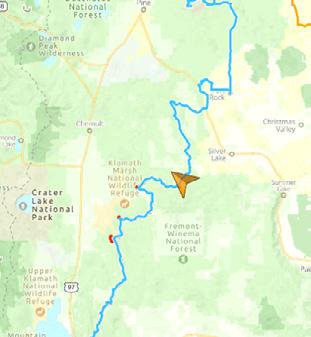
After a peaceful night’s rest, you will continue your journey towards the iconic Fort Rock, a geological marvel rising from the desert floor. Before reaching Fort Rock, stop and stretch your legs by exploring Hole-in-the-Ground, which is a huge maar depression about a mile across and 500 feet below ground level. A volcanic explosion created this crater between 13,000 and 100,000 years ago.
As you make your way to Fort Rock, you will be mesmerized by the sheer size of the hole and perfectly round formation that rises above the stark desert. There is a great trail, bathroom, and information at the visitor parking lot at the base of the formation. Be sure to stop in
at the Fort Rock Homestead Village Museum in the small town and wet your whistle at the rustic bar. Stock up on water here if needed, as there are no other services available. There is plenty of camping right outside of Fort Rock. We chose to camp at China Hat campground, which has no fee and provides picnic tables and fire rings. We had a nice fire and starlit sky and were the only ones there when we visited in early June.
Main image: Dispersed camping is allowed in the Klamath National Forest, which offers a variety of camping opportunities. Ensure you follow Leave No Trace principles and check for any fire restrictions or specific regulations. 1: The author taking a moment to take in the views at Klamath Lake, which is renowned for its diverse bird populations and is a key habitat for many species. 2: A starting point for this four-day offroad adventure. 3: Fort Rock is a striking volcanic landmark that rises tall out of Oregon’s high desert. The tall jagged rock walls make a unique ring-shaped formation, making it feel like a fort — thus its name. This area has rich archaeological history. Photo courtesy of Oregon State Parks. 4: The author at the rim of the Hole-in-the-Ground, a huge crater-like structure formed by volcanic activity thousands of years ago. 5: The parking lot and trail head to Fort Rock.


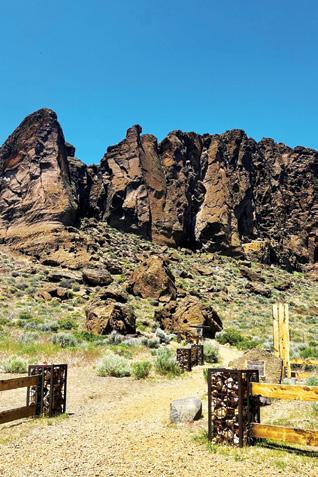
Embarking on an overland adventure is an exhilarating experience, but ensuring your vehicle is properly outfitted is crucial for a smooth journey. Whether you’re traversing rugged terrain or venturing into remote areas, having the right gear can make all the difference. Here are ten things to consider when outfitting your overland vehicle for any expedition:
1. Communication and GPS Navigation
Make sure you are equipped with a reliable GPS navigation system and communication devices such as a two-way radio or satellite phone. These tools are essential for staying on course and for emergencies in areas with limited or no cell reception.
2. Recovery Gear
Prepare for unexpected obstacles with recovery gear like a high-lift jack, tow straps, shackles, and a sturdy shovel. These tools will help you navigate through mud, sand, or snow and recover your vehicle if it gets stuck.
3. Storage Solutions
Maximize storage space with roof racks, cargo boxes, or storage drawers. Organize your gear efficiently to optimize interior
space and keep essentials easily accessible.
4. Power Sources
Invest in a dual battery system or portable power packs to keep electronic devices charged, run a fridge or cooler, and power other essential equipment during your journey.
5. Water and Filtration
Carry ample water supplies and a reliable water filtration system to ensure access to clean drinking water, especially when traveling through remote areas where water sources may be scarce or contaminated.
6. Food and Cooking Equipment
Pack non-perishable food items, cooking utensils, a portable stove, and a fuel source for preparing meals on the go. Consider
a compact refrigerator or cooler to keep perishable items fresh for longer periods.
7. First Aid Kit
A well-stocked first aid kit is essential for handling minor injuries and medical emergencies. Include essential items such as bandages, antiseptics, medications, and emergency medical supplies.
8. Emergency Supplies
Prepare for unforeseen circumstances with emergency supplies like a fire extinguisher, flashlight, emergency blankets, and signaling devices. These items can be lifesaving in emergency situations.
9. Vehicle Maintenance Tools
Carry a basic toolkit, tire repair kit, air compressor, and spare parts specific to your vehicle.
Regular maintenance checks and the ability to make repairs on the road are essential for keeping your vehicle running smoothly.
10. Comfort and Survival Gear
Pack sleeping bags, tents or shelter systems, and clothing suitable for various weather conditions. Additionally, consider items such as insect repellent and sunscreen to ensure comfort and safety during your adventure.
By equipping your overland vehicle with these essential items, you’ll be well-prepared to tackle any terrain and enjoy a memorable journey filled with adventure and discovery. Always remember to prioritize safety, preparedness, and responsible exploration while venturing into the great outdoors.

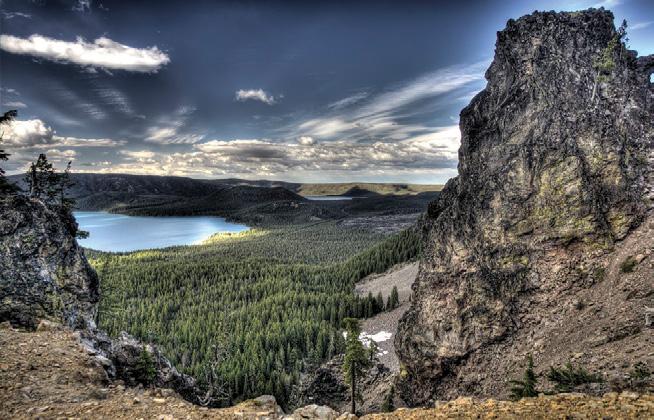
Your next destination is the aweinspiring Newberry National Volcanic Monument, a surreal landscape dotted with lava flows and towering Ponderosa pines.
Navigate to the Tree Molds Trail, which boasts ample parking and restroom facilities. As you walk along the level one-mile trail, you will discover the remnants of ancient trees preserved in volcanic ash, a testament to the cataclysmic events that shaped this region millennia ago.
As dusk descends, select a dispersed camping spot along one of the many
dirt roads. We chose an established site with a pre-existing fire ring at the base of a small cinder cone mountain. We enjoyed an evening hike to the top of the cone and had a sunset display of Peregrine falcons throughout the darkening sky.
On your final day, bid farewell to the wilderness as you make your way to the vibrant city of Bend, Oregon. Along the route, pause at Big Obsidian Flow, a geological wonderland where obsidian glistens amidst the mountains.
Traverse the slopes of the flow on a picturesque trail adorned with black
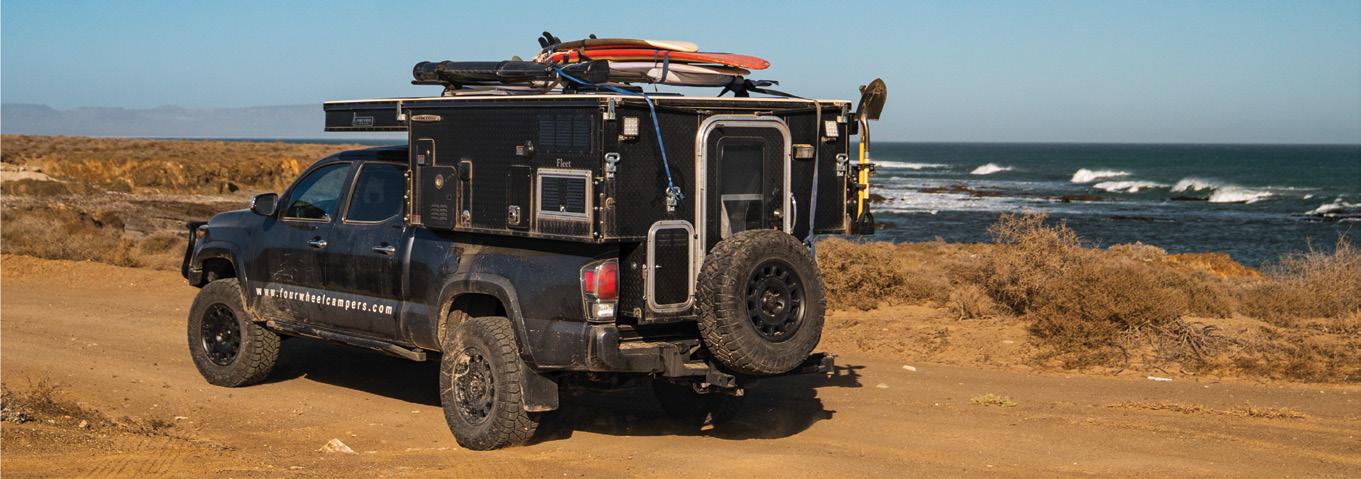




6: Sunset at dispersed camp outside of Newberry National Volcanic Monument. 7: Newberry National Volcanic Monument showcases a diverse volcanic landscape, featuring cinder cones, lava flows, and pristine lakes. 8: The author on Tree Molds Trail, where the imprints of ancient trees preserved in volcanic ash offer a glimpse into the area’s geological history. 9: The hike up Big Obsidian Flow offers a unique and striking landscape for visitors to explore. 10: Close up view of obsidian — a natural volcanic glass that forms when lava cools rapidly. 11: Upper Lake at Big Obsidian Flow offers tranquil waters and stunning views of the surrounding volcanic terrain.
glass. Obsidian, a prized resource utilized for weapons, tools, and trade, lends a rich history to this site. At the summit, savor panoramic views of the surrounding landscape, and take in the beauty and history.
As you roll into Bend, you can choose any number of accommodations from 5-star hotels to dispersed camping
in the Deschutes National Forest lands. You should feel a great sense of accomplishment having completed one of the segments of the greatest overland trail in North America. Giving testament to the enduring allure of adventure and exploring the road less traveled. Hope to see you out there!

From the natural beauty of the desert and redwoods to the bustling energy of city life, these detours offer diverse experiences as you make your way north.
Anza-Borrego Desert State Park: Explore rugged canyons and blooming wildflowers in California's largest state park.
Sequoia and Kings Canyon National Parks: Stand beneath the towering giant sequoias in the Sierra Nevada Mountains.
Yosemite National Park: Marvel at granite cliffs and thundering waterfalls in the iconic landscapes.
San Francisco: Take a break in this vibrant city, home to the Golden Gate Bridge, Alcatraz Island, and diverse culinary delights.
Avenue of the Giants: Drive through Humboldt Redwoods State Park surrounded by ancient coastal redwoods, some of the tallest trees on Earth.
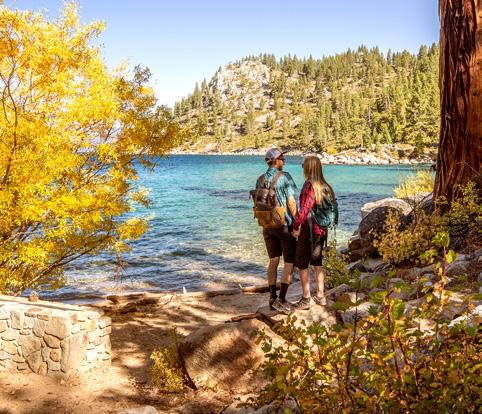

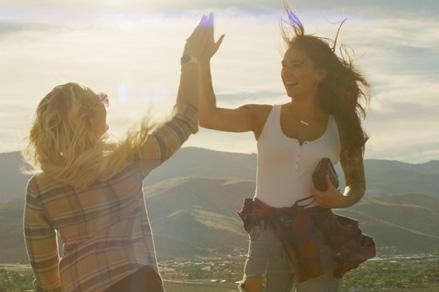
Memories are measured in smiles, road trip snacks, and skinned-knee souvenirs.
The kind of road trip that requires the bike rack, letting the kids get soaked in the mountain rivers, and saying yes to staying up late to roast marshmallows.
The good old days are happening now.
NOW OPEN!
CONNECTING CARSON CITY TO TAHOE WITH 16 MILES OF SINGLE-TRACK FOR HIKING, HORSES, BACKPACKING AND MOUNTAIN BIKING!
By Kurt Gensheimer

With any successful community-driven movement, being in the right place at the right time with the right message is everything. In the case of Truckee, California-based Truckee Dirt Union (TDU), all of those elements and more have lined up since its founding in 2020. A 501c3 non-profit focused on creating positive outcomes for mountain biking through collaboration and good times, TDU is an example of how a community can engage and help shape a vision for its own future.
In its short existence, TDU has successfully tapped into a vein of energy in the local Truckee community, drawing on its 600-member Volunteer Trail Force to support a handful of community trail builders who’ve been working in the woods for 30 years, creating a recreation-driven economic engine in Truckee, making the town a worldclass mountain biking destination.
But you don’t have to take this author’s word for the success of TDU.
Simply drive Highway 89 south from Truckee towards Tahoe City, and only a couple hundred yards past the River Street traffic light, on the right-hand side is the proof; dozens of cars, trucks and vans with mountain bikes on racks, with parents, kids and core lords getting ready for an afternoon shred
on the trails of Jackass Ridge, recently renamed Donkey Town.
In the last five years, the Donkey Town trail network has exploded in popularity, making it one of the most popular spots to ride a mountain bike in the entire Lake Tahoe region, rivaling even the iconic Corral Trail network in South Lake Tahoe. There are a few reasons for this explosion in popularity, but the common ingredient in all of those reasons is TDU. Established during the height of COVID in April of 2020, TDU came together in a great time of need for the community.
“There was a looming threat by the government to shut down access to all recreation in our community,” said TDU co-founder and Executive Director Matt Chappell. “But recreation is the saving grace of our community and one of the
main reasons why we live in Truckee, so we couldn’t let that happen.”
Chappell and fellow co-founders Skye Allsop and Greg Forsyth, worked up a COVID-friendly messaging and signage plan on the Donkey Town trail network, encouraging riders to keep safe distance from one another, not to ride in packs and not congregate at trailheads in the interest of keeping the trails open for public use. As owner of Olab Design, a local graphic design and brand development studio, Chappell’s experience with visual communication was a perfect fit for TDU’s first project as an organization.
TDU messaging was a success, and the community was able to continue recreating throughout COVID on the Donkey Town trail network. During that time, the popularity of mountain

of
for
and


biking exploded in Truckee, as it did all over the country. There were suddenly hundreds of new riders, and a new energy arriving in the sport.
TDU capitalized on its successful messaging campaign, leading to developing a community stewardship program with the US Forest Service in collaboration with Truckee Trails Foundation (TTF) to support official adoption of the user-built, unsanctioned Jackass Ridge trails, constructed nearly 20 years ago. While TTF did the environmental work with the Tahoe National Forest to legitimize the trails, TDU assembled its newfound Volunteer Trail Force to go out and do the necessary maintenance and reroute work on the ground through community stewardship.
“We’re all yearning to be in the forest, it’s like medicine for the soul,” said Chappell. “Our goal at TDU is to take mountain biking in Truckee from a 7 to an 11 on the fun scale.”
Based on attendance at TDU trail day events, even on a weekday, when TDU puts out the call to its volunteers, people show up. Of its 600 members, the TDU Volunteer Trail Force regularly has a 10% turnout, an impressive number for any trail organization, let alone one that is only four years old.
“I think the reason why we get such a good turnout is because people love the Donkey Town trails,” explained Chappell on Episode 22 of Mind the Track podcast. “All TDU has done is created an effective platform of communication and belonging, harnessing positive energy to improve Truckee’s coveted trails.”
For those who’ve never ridden Donkey Town, it can be best explained as a trail network that’s fun for all skill levels and ages. The secret to the trails’ success lies in TDU’s core trail builders, Jonnie Benda, Rob “Hodo” Holodinski, Joel Severy and Chris Kelly, who
“There
was a looming threat by the government to shut down access to all recreation in our community. But recreation is the saving grace of our community and one of the main reasons why we live in Truckee, so we couldn’t let that happen.”
— Matt Chappell, TDU co-founder and Executive Director
understand the concept of flow, how to build proper transitions and creating optional jumps predictable for those looking to progress their skills.
Benda, the leader of the crew, is “the shaper”; the final word on any new corner, jump or feature. He’s also the curator of creativity in the network, making all the hand-painted signage and dioramas of Hanna Barbera cartoon figurines peppered throughout the forest. Benda has been digging and riding in Truckee for more than 30 years, and understands the concept of flow and momentum better than anyone. He is the man behind all of the trails in Coldstream Canyon, including JP Trail, a trail that Forsyth considers the first purpose-built mountain bike trail in Truckee.
Forsyth moved to Tahoe City in 1982, and has been an instrumental part of mountain biking’s history in the region. As the owner of CyclePaths Bike Shop in Truckee, established originally in 1985 as a touring company, in addition to being a co-founder of TDU, Forsyth also co-founded the Tahoe Area Mountain Biking Association (TAMBA) in 1988.
“Before JP Trail, there really wasn’t much trail in Truckee suited for mountain biking,” said Forsyth. “When the Pacific Crest Trail closed to mountain bikes in 1988, it left a big void, as we used to ride the PCT a lot.” Benda moved to Truckee in 1991, saw the need for mountain bike oriented trail and started building JP. The J is Jonnie, and the P is Patrick, Benda’s long-time friend who helped him over the course of 13 years, building 3.5 miles of trail on the manzanita-choked south face of Schallenberger Ridge near Donner Memorial State Park. JP Trail was an instant success, becoming the most popular mountain bike trail to ride in Truckee at the turn of the millennium.

Above: Adding to the unique riding experience, Jonnie Benda plays some Metallica on an old cassette radio he stashed in the woods for people to enjoy (Ryan Salm). Opposite Page, clockwise from top: Dioramas are one of Jonnie Benda’s signatures he places along each trail, adding character to his craft (Matt Chappell); Passion for trails with a family-friendly environment is the calling card of TDU (GP Martin); TDU members celebrate community at the July 4th parade in downtown Truckee (GP Martin).
always been the unsanctioned status of mountain bike trails in Truckee, including JP Trail, which has been an unsanctioned trail since its construction 30 years ago.
“Word-of-mouth says there’s approximately 230 miles of user built trail in the Truckee area and 200 miles of legal trail,” said Chappell. “TDU is going through the proper protocols to meet the requirements of landowners
and stewardship partners, in the hopes of keeping community assets like JP Trail.”
Building on all the work TDU has been doing to maintain, enhance and expand the Donkey Town trail
The secret to the trails’ success lies in TDU’s core trail builders, Jonnie Benda, Rob “Hodo” Holodinski, Joel Severy and Chris Kelly, who understand the concept of flow, how to build proper transitions and creating optional jumps predictable for those looking to progress their skills.
network, the next big project for TDU is working in partnership with the California Mountain Biking Coalition, Truckee Donner Land Trust and Donner Memorial State Park to adopt and improve JP Trail, eventually making the trail a part of the bigger Donner Rim Trail.
The JP Trail project will give TDU experience in doing the environmental review work required of all trails before



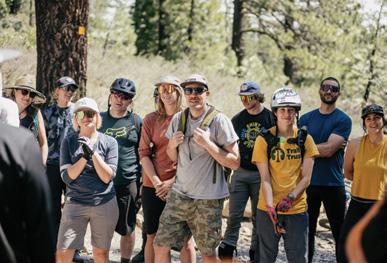
“Our goal at TDU is to take mountain biking in Truckee from a 7 to an 11 on the fun scale.”
— Matt Chappell
becoming legal, as well as another opportunity to put its Volunteer Trail Force to work, completing a couple of reroutes and enhancements before the trail is formally adopted.
TDU has ambitious plans for the future, but there are already a few other trail organizations in Truckee doing good things for the community, so why was there a need for TDU?
“The existing organizations had a broad paintbrush of what they were doing in addition to trails like bike paths and bike lanes,” said Forsyth. “There wasn’t anyone specifically dealing with dirt and mountain bikes. Because of all the social mountain bike trails, information was hush-hush. It was evident mountain bikers needed a formal connection between the community and trails, working with the Forest Service.”
Without funding, there can be no trails, which is why one of the most important elements of TDU is its focus on supporting the long-time community builders responsible for much of the routine trail work. Community builders work out of their own passion for trails without pay, but the recreation economy they fueled through mountain biking in Truckee is considerable, and TDU is now getting builders paid for their work on some of Truckee’s coveted sanctioned trails. All public donations to TDU go straight back into the trails, paying TDU’s builders to maintain the trail

network, keeping it in prime condition all summer long.
The Truckee business community has also recognized the importance of TDU’s efforts and are engaging in support. At local establishments like New Moon Natural Foods and Pacific Crest Coffee, customers can contribute to TDU. Tahoe City-based apparel company Flylow has donated TDUbranded baseball caps for fundraising, and Alibi Ale Works in Truckee did a beer collaboration with TDU, creating Singletrack Radness, the perfect postride pale ale, with proceeds going back to TDU. The Tahoe Truckee Radio Station 101.5 has even created a radio program with TDU called “The Singletrack Report”.
But at the end of the day, Forsyth highlights that all people really want to do is get outside with like-minded folks and be a part of something bigger.
“People don’t look at themselves as trail builders, they just want to get on the dumb end of the shovel and fill that wheelbarrow,” said Forsyth. “We’re all going have a good time and we’re all going to ride this new feature we build together. That is inspiring to people, and more people show up every time.”

For more information on Truckee Dirt Union and how you can volunteer and donate, visit truckeedirtunion.org and follow them on Instagram @truckeedirtunion


By Anthea Raymond

November marks the 50th anniversary of the vote on California Proposition 17, a citizen-initiated measure aimed at preventing the construction of a dam on the Stanislaus River. The dam would flood a popular section of the river known as Camp-9. Although the vote was close, the dam was ultimately built, destroying this pristine section of the river.
Despite this defeat, a significant victory emerged: the failed effort to stop the dam inspired a generation of kayakers and rafters to become activists, united by the conviction that “never again” should a dam be allowed to destroy a wild river.
At the time, the idea of using a popular vote to change state law was a new one, at least in the context of designating the river as “Wild and Scenic” to block the dam. Heading the signature collection needed to put Prop. 17 on the ballot was the newlyformed Friends of the River (FOR). FOR lives on and over the years has extended its attention to issues on numerous California rivers and creeks including the the North Fork of the American, the Kings, the Merced and the Upper Klamath.
A number of individuals share credit as FOR cofounders. But only one of them has a namesake river feature — Merals Pool on the Tuolumne.
Jerry Meral was born in Detroit, and came to California in 1967 to get a PhD in zoology at UC Berkeley. He had attended Penn State and planned for the bigger rivers of the west by trading his metal canoe for a lighter and nimbler fiberglass vessel called the C-1.
“I had run up to Class IV in my decked canoe, but I knew no one in California did that,” he said. “There were just a few other C-1 paddlers at that time.
Meral made the C-1 by hand, along with the rest of his gear. “Early on, many people believed life jackets were dangerous, since they might trap you in a hole,” he said. “We made our own Naugahyde spray decks, fiberglass canoes, life jackets, and even paddles. If it was cold we wore full wetsuits.”
Moving to the fiberglass and low-volume vessel made it possible for Meral to join others in taking on challenging and uncharted runs like the Tuolumne River’s Class IV section below Lumsden Campground and the Class V Cherry Creek run above it — Merals Pool linking the two runs is named after Meral’s highwater swim there.
“Many of the rapids on the Tuolumne — Meral, Sunderland, Ram’s Head — are named after swims or flips,” he said. “Other names are for Hackamack and Gray, who fought to save the river. Very few features are named after people who made successful runs.”
Meral paddled a C-1 until 2002, through many improvements in kayak design and construction. Only the discomfort of paddling on his knees finally got him into a kayak.

Meral was also part of the crew that took thengubernatorial candidate Jerry Brown down the Stanislaus in 1974. And he went on to serve in both Jerry Brown administrations as a conservationist and scientist. He was Deputy Director of the California Department of Water Resources from 1975 to 1983. In 1980, he and his team prepared the documents that led to the Carter administration designating sections of the Smith, Eel, Klamath, Trinity and American rivers


as Wild and Scenic — granting them federal protection, the highest possible. Meral returned to Sacramento in 2011 to serve as Deputy Secretary of the California Natural Resources Agency until 2013. Given another shot in Sacramento, he said he’d want to be Resource Secretary given the department’s ability to influence environmental policy.
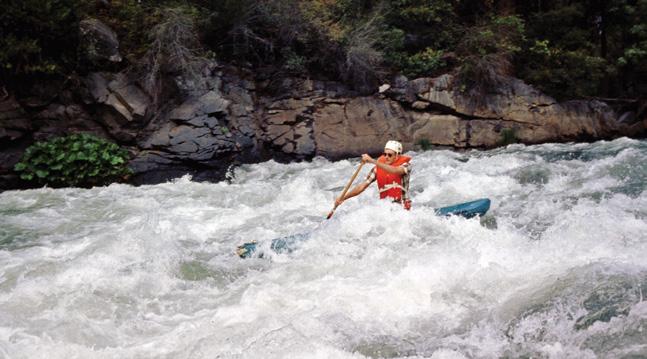

Meral thinks the California Department of Parks needs to do more for rivers, and to promote whitewater and flatwater boating — not just powerboating. He was a recent guest on the Department’s co-sponsored podcast Dockside that should bring attention to that issue.
1.Top, left to right: River guide and Friends of the River Stanislaus campaigner Graciella Rossi on the Stanislaus at Bailey Falls, perfectly capturing the spirit of early 1970s rafting (StanislausRiver.org); Jerry Meral in his C-1, 1971, also at Bailey Falls (StanislausRiver.org). Bottom, left to right: This blow-up, military surplus decoy truck floated 200 miles on a raft during the 200-mile Row for the River supporting Prop. 17 (StanislausRiver.org); ARTA River Trips guide Elizabeth Black playing the role of a threatened river in a theatrical skit at the first major rally at the State Capitol to save the Stanislaus in September 1975, just before the wild river legislation was introduced in early 1976 (Bruce Raley’s Collection / StanislausRiver.org).
On the podcast, he also shared his concern over the shrinking number of younger paddlers he sees on the water. He says it’s neither good for the sport nor the future of river conservation.
“River runners then and now fall into one of two groups. Those who simply enjoy doing it, and those




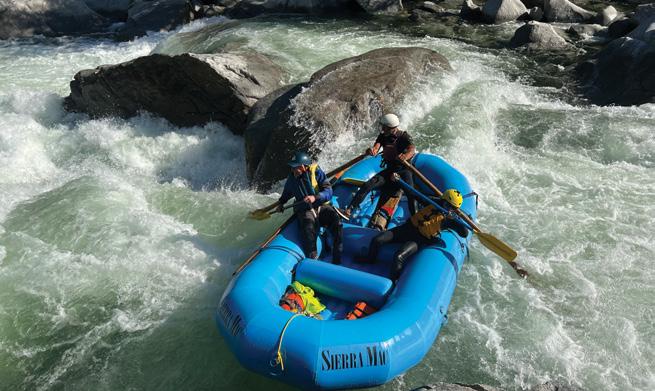



“River runners then and now fall into one of two groups. Those who simply enjoy doing it, and those who take



Clockwise from top: Jerry Meral rafting Cherry Creek, Summer 2023 (Sierra Mac River Trips); Jerry Brown preparing for a trip down the Stanislaus in spring 1974 to announce his support of Prop. 17 (David Kay / StanislausRiver.org ); ARTA River Trips’ Larry Orman guiding then-gubernatorial candidate Brown and down the Stansilaus, with Meral and key campaign member Rob Caughlan up front (David Kay’s Collection / StanislausRiver.org); Meral in 1982 (Tim Palmer / StanislausRiver.org).
who take conservation action,” he said. “Unfortunately, both groups are a lot smaller than 50 years ago. Friends of the River has not solved the problem of continued engagement, nor has the Tuolumne Trust, though they keep trying.”
Meral credits the Sierra Club’s nowinactive Bay Area Kayak Touring section for helping him connect to the wider paddling community when he moved to California — and for kicking off his activism with a trip to the Stanislaus. He also met his wife through the club. He noted that the decline of these kinds of organized paddling groups may be a barrier to entry for newer paddlers today. He added, “I think people just find their own small groups, and go out together. Perhaps they meet in kayak schools?”
He does see hope in clubs like Chico Paddleheads and Gold Country Paddlers, who are carrying on the tradition.


By Leonie Sherman

Though we call it planet Earth, we live on a water world that’s 71% liquid. According to the movie Chasing Coral, over 90% of the heat created by burning fossil fuels has been absorbed by the ocean. If the ocean hadn’t absorbed that heat, the average temperature on the planet would be 122 degrees.
“The ocean has already saved the entire human race from annihilation!” exclaims Michael Stewart, co-founder of the non-profit Sustainable Surf. “The ocean gives us a stable climate and is also a carbon bank for the world. We started Sustainable Surf in 2011 hoping to become the blueprint for how to restore and bring back ocean health and reverse climate change.”
Co-founders Stewart and Kevin Whilden and Sustainable Surf’s staff of dedicated globe-trotting surfers believe the ocean is the hidden hero in our collective story about combating climate catastrophe. “Trying to solve any of those seemingly intractable global problems without including ocean ecosystems as a core part of the solution is pure fantasy,” Stewart explains. “Marine ecosystem restoration is the key to saving carbonbased life on our planet.”
Even though most efforts to fight climate change focus on terrestrial actions, the ocean takes the brunt of the impact. “Pollution, loss of biodiversity, all those things show up first in the ocean,” explains Stewart.
“As surfers, we’ve seen this more than most people. I’ve seen coral reefs and beaches disappear, kelp forests completely decimated, all from the impacts of a warming world, a warming ocean.”
Yet surfing culture and business falls far behind other land-based outdoor adventure industries when it comes to fighting climate change. Sustainable Surf aims to change that by combining innovative programs and digital storytelling with surfer stoke. “There is already enough education and awareness out there,” Stewart says. “What we need is very specific fins in the water action. We wanted to provide an on-ramp, a pathway for others to take action and become part of the solution.“
The Ecoboard Project
Stewart and Whilden decided to start with the surfboard. “There’s nothing more central to being a surfer than their surfboard. But a modern surfboard is a solidified toxic stew of petrochemicals,” explains Stewart. “That’s the core ingredient we base all this love and passion for the ocean on. So what would a more sustainable surfboard look like?”
Surfboard manufacturing has remained remarkably consistent for the past half century. “Think about a cell phone or a car, asking someone to build those things using only technology from the ‘60s, that would be ridiculous,” Stewart exclaims. “But that’s where the surf industry was at when we started our Ecoboard program.”
The Ecoboard Project is a certification program for surfboards, similar to the organic label for food, aiming to define and measure sustainability in the
This page: Portuguese professional surfer Miguel Blanco puts his newly developed Ecoboard through the paces. The core of this board comes form a company called Polyola which has a 70% reduction in CO2 emissions compared to a traditional surfboard of the same size. Opposite page, left to right: Stefan with Kuntiqi Surfboards shows off one of his beautiful wooden longboards at his showroom in the north of Spain (Tyler Fox); An example of the Ecoboard verifications logos on Blanco’s quiver of high performance shortboards (Tyler Fox).
materials used to build surfboards. “We thought, we could create a process for folks to demonstrate they’re adhering to a more rigorous standard to reduce carbon footprint and use plant-based or recycled materials,” explains Stewart. “That was the birth of our Ecoboard program.” Thirteen years later, they have 141 partners.



“There’s a misconception that an Ecoboard will take away from the performance,” admits Ecoboard Program Manager Tyler Fox. “But we have some absolutely shredding surfers on our boards.”
And while buying a new surfboard may not change the world, it can change the way people think. “It’s a conversation starter,” explains Fox.
“It’s a simple small step folks can take towards understanding how climate change affects their ocean, their waves. Ultimately we want to shift the needle so it becomes a normal thing for folks to get boards produced in an
I was on my board from dawn until dusk for three and a half days. After 8-12 hours a day of paddling on it, swimming in it and drinking it, I felt like I was becoming Lake Tahoe.
The Ecoboard Project is a certification program for surfboards, similar to the organic label for food, aiming to define and measure sustainability in the materials used to build surfboards.
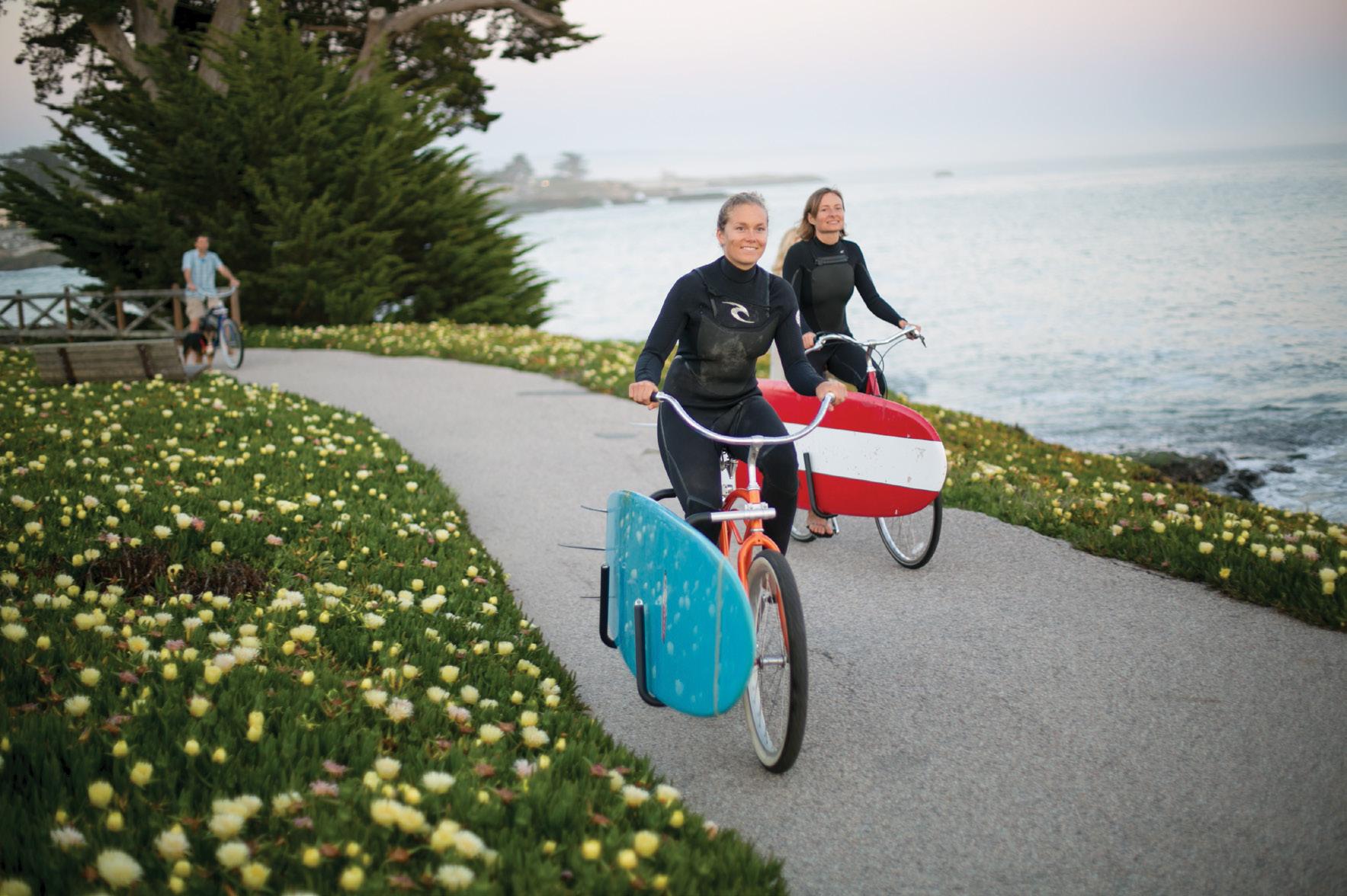


cure,” explains Stewart. So they started a program called SeaTrees.
“SeaTrees is not the actual fins in the water, but we partner with folks all over the world who are,” explains Leah Hays, SeaTrees Program Manager. ”We also fund science impact measurement and do a lot of media production. As our partners are able to tell their stories more effectively and reach a
wider audience, they can attract more funding and partners.”
SeaTrees currently has 23 projects on every continent except Antarctica, in six critical marine habitats: mangroves, kelp forests, coral reefs, coastal watersheds, seagrass meadows and oyster reefs.
Kenya is the epicenter of their mangrove restoration work, which will be featured in the upcoming BBC
series Blue Horizons. Community partners collect seeds and propagules, raise them in nurseries and then transplant them to designated areas. A community sensitization program shares knowledge about how mangroves buffer rising sea levels and increase biodiversity. Some locals report that fishing is improving in areas where mangroves are protected.
Perhaps most importantly, SeaTrees aims to understand the underlying
The issues underlying kelp forest decimation vary with location, and SeaTrees adapts their approach to each project site.
issues in each location where they partner on projects. “We know the main cause of mangrove degradation is poverty,” explains Hays. “So we support local partners in starting a woodlot program to encourage folks to grow wood they can harvest instead of cutting mangroves. We employ community members to collect seeds and raise seedlings. Community groups have pooled their earnings to begin alternative livelihood projects like beekeeping, raising chickens, goat rearing, and making climate resilient food forests.”
The issues underlying kelp forest decimation vary with location, and Sea Trees adapts their approach to each project site. In California, they focus on removing purple sea urchins. Warming ocean temperatures led to massive sea star die offs, which resulted in overpopulation of ravenous purple sea urchins. “There is no point in planting kelp there, the urchins would eat our


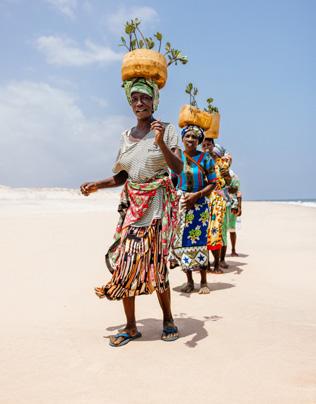
efforts,” explains Stewart. “So we go in and remove the urchins from specific reefs and allow natural regeneration to take place.”
But in the marine environment around Sydney Australia, kelp (or crayweed as they call it down under) was eliminated by polluted runoff over forty years ago. “The underlying water pollution problem has been addressed — Sydney invested in better water treatment systems,” explains Stewart. “So we work with local partners to transplant healthy kelp from nearby forests. We attach it to rocks and boulders.”
In the SeaTrees Portugal project they are starting a nursery of baby kelp plants inside a submerged shipping container. They impregnate tiny rocks or gravel with kelp spores, grow them in a protected environment until they’re viable and then release them on top of a reef system. “They’re already growing when they hit the ground!” explains Stewart.
Cool reefs all over the world are endangered by ocean acidification — which dissolves their hard bodies and shells — and warming, which bleaches their vibrant colors when algae die off. “Coral is the biggest warning sign of what we are doing to the operating system of the earth,” explains Hays. “These reefs are diverse charismatic underwater wonderlands. Nobody wants to see them disappear.”
So SeaTrees works on coral restoration
1. Opposite page: SeaTrees Kelp Restoration Science Project dive site off the coast of La Jolla, CA (Mike Borchard). Opposite page, top to bottom: Diver with restored coral reef at SeaTrees Coral Restoration Project in Bali, Indonesia (Ocean Gardener); Local women of Marereni, Kenya at SeaTrees Mangrove Planting Project site (Talisa Lanoe).
all over the world. On a small island off the coast of Bali, they are using indigenous seaweed farming techniques to propagate coral and create new reefs. In the Caribbean they study which corals are resilient to bleaching events so they can grow and plant thermally resistant ones. And they’re about to sign a contract in Fiji to eradicate crown-of-thorns starfish, which are ravaging reefs there.
Their work restoring coastal watersheds is focused in Launiupoko, a town on Maui near where the devastating fires occurred. Two weeks before the fire, their project partner cleared a bunch of invasive species which essentially acted as a fuel break, slowing the fires advance. “That site sits right above what’s commonly known as the Mother Reef, because it holds the oldest coral on the island and acts as a nursery for three islands,” explains Hays. “By removing invasive species and planting natives we are able to restore this historic watershed and assist the reef below by mitigating run off, controlling erosion and filtering chemicals from farming.”
SeaTrees is also studying the benefits of seagrass meadows in Mallorca and Portugal, as well as oyster reefs off the coast of Maine.
In just twelve years, Stewart and Whilden have changed surfboard manufacturing and contributed to scientific and community-based marine climate solutions. “Our secret sauce is fun,” explains Stewart. “Yes, we may be working on some of the most difficult environmental issues in the world but we do it with optimism. We make it cool and interesting, we feed the stoke. That’s really the bread and butter of Sustainable Surf.”



By Leonie Sherman

Out for a casual paddle on Lake Tahoe last summer, a friend mentioned that Alex Honnold had crossed the lake by paddleboard under a full moon to celebrate his 40th birthday. Like anything Honnold does, I figured that was not a reasonable goal for a regular human. But by the end of the day my friend and I had paddled almost 18 miles. I realized that I won’t ever be able to free solo El Cap, but I can still take inspiration from one of the best rock climbers alive and become one with Lake Tahoe.
But when I started asking around, everyone from the Forest Service to friends to fisherfolk told me it wasn’t safe and I should under no circumstances attempt to cross the lake unsupported in the dark. Inattentive boat captains would run me over. Whitecaps in the middle of the lake would be six feet tall. I was sure to fall in and die. I decided to gather my own beta by circumnavigating the lake on my SUP before I attempted to cross it. So a 15-20 mile adventure turned into an 85-100 mile expedition.
I brought a paper map, but navigation was not an issue. I did meet one poor lost kayaker who’d managed to get so disoriented they couldn’t figure out where they came from. I knew if I kept the land on my left I’d eventually end up right where I started.
Tahoe has no currents or tides, but plenty of wind, a stand up paddler’s natural enemy. If you
want to paddle Tahoe for a mile or 70, check the wind forecast on a reliable site or app and do not underestimate its ability to transform a glassy giddy paddle into a grim cold suffer-fest in moments. Bring some extra food and a flexible mindset. Some of my best camping was forced on me by fierce winds. Ditch the goal and embrace the journey.
With plenty of infrastructure, and mild weather, Tahoe is a glorious SUP tour. Kayaks have more speed and maneuverability, but SUPs are way more comfortable. When I think back on kayaking Lake Tahoe over a decade ago, all I remember is the agony of sitting in an L shape all day. On an SUP, I can sit, kneel, stand, lie down, and do yoga. Launching and landing are easier on an SUP than in a kayak.
As for storage, I figured if I can strap everything i need for a week onto my back, I can strap it
onto an 11-foot SUP. In fact my board can carry more than my back, so I brought a heavy book, a cozy inflatable pad, and an electric toothbrush. Surprisingly, the extra weight didn’t affect my balance much. SUP touring is like bike touring, on the water, without the risk of being flattened by a semi.
Of course, on Lake Tahoe, at the height of summer, you risk being swamped by the wake from a a jet ski or motor boat. I started paddling every day at dawn to minimize those encounters. As night transitioned to day, the glassy waters reflected peach sherbet, cumulus puff balls, lavender hues and snow-capped peaks. The ripples from my board created the only texture on the vast alpine mirror. I was literally walking on water, floating on clouds.
At first, I imagined I’d stop frequently to hike, do yoga and chill out on beaches. But once I

Opposite page: Headed into Emerald Bay, early morning (Leonie Sherman). This page, left to right: The author setting off on her adventure (Bob Goodall); Headed towards shore at dawn after crossing the lake under a full moon.
dropped into the rhythmic, hypnotic meditation of paddling, I didn’t want to stop. Like, ever. I was on my board from dawn until dusk for three and a half days. After 8-12 hours a day of paddling on it, swimming in it and drinking it, I felt like I was becoming Lake Tahoe.
I also felt like I was becoming extremely sunburned. No amount of sunblock will protect you from that much solar radiation. Casual paddlers looked adorable in their bikinis and board
shorts. I looked like a maritime Bedouin in a thin long sleeve shirt, thin pants, a light scarf wrapped around my face and a trucker cap. Even so, my hands and feet got scorched. Next time I’ll wear thin gloves and socks.
Each night when I stepped ashore the ground rocked and rolled beneath me. When I lay down to sleep, I could still feel the Earth swaying like a restless ocean. That feeling faded more quickly after a four day sailing trip than after four days

I was on my board from dawn until dusk for three and a half days. After 8-12 hours a day of paddling on it, swimming in it and drinking it, I felt like I was becoming Lake Tahoe.
paddling Lake Tahoe.
I reckon if a body of water is big enough to give you sea legs, it’s big enough to merit protection. In 1972 California voters passed Proposition 20,


creating the Coastal Commission. Tasked with protecting, conserving, restoring and enhancing over 1,000 miles of shoreline, they work to ensure public access and recreation, lower accommodation costs, and regulate agricultural lands, commercial fisheries and industrial infrastructure. They have the authority to control any development within a defined coastal zone and have been called the single most powerful land-use agency in the country. Tahoe deserves its own Coastal Commission.
Just a year before Prop. 20 passed, over 80% of Tahoe’s shoreline was privately owned and off limits to all but a lucky few. Thanks to hard work by the Tahoe Conservancy and other local advocates, almost half of the shoreline is now open to the public. Personally, I believe a lake that big and spectacular is a public good that should be protected and preserved for all to enjoy. But I don’t make the rules, I just paddle the board. I mostly stayed close to shore for safety. Every time I passed a public


beach or park I pulled over to use the facilities and relax before pushing on. Though more than half of Tahoe is off limits and privately owned, it’s reassuring to know that if disaster struck you could pull over and ask for assistance.
And then, less than four days later, I was right back where I started. Everything around me looked the same, but something inside me was different. Circumambulating a lake, island or mountain under your own power is a holy act that figures into many world religions and pilgrimages. Find your own circuit and enjoy the journey.

As for storage, I figured if I can strap everything I need for a week onto my back, I can strap it onto an 11-foot SUP.
Paddling on Lake Tahoe can be dangerous due to sudden weather changes, cold water temperatures, heavy boat traffic, and the lake’s high elevation, so it’s essential to take proper safety precautions and to always have a plan.
The Sierra Business Council released the Lake Tahoe Water Trail Map & Access Guide to help paddlers find their way along the 72-mile water route. The access guide is intended to be used with the Lake Tahoe Water Trail website and is a great resource for planning your next adventure.
LakeTahoeWaterTrail.com
Also, make sure you know how to check your boat, board and gear for aquatic invasive species (AIS) before entering the lake. Watercraft are the largest source of spreading AIS. The best way to prevent the spread is to always clean, drain and dry your gear after exiting the water. TahoeKeepers.org is a great resource for learning how to do your part to protect Lake Tahoe from AIS.
After you’ve checked your gear, make sure you have a plan before doing any paddling or adventuring on Tahoe’s big alpine lake. Do not underestimate the serious conditions that can come, sometimes without warning. Always make sure to check the wind and weather before getting on the water, and let people know what your plan is.

6 — Watsonville Criterium / Watsonville / VeloPromo.com
11-14 — Downieville Classic / Downieville / DownievilleClassic.com
13 — Death Ride - Tour of the California Alps / Markleeville / DeathRide.com
27 — Dodge Ridge Enduro / Pinecrest / CaliforniaEnduroSeries.com
3 — Tour de Big Bear / Big Bear Lake / BigBearCycling.com
10 — Dunnigan Hills Road Race / Dunnigan / VeloPromo.com
17 — Pedalpalooza / Mammoth / sembabike.org/pedalpalooza
17 — Cool Breeze Century / Ventura / CoolBreezeCentury.com
17–18 — Northstar Enduro / Truckee / CaliforniaEnduroSeries.com
18 — University Road Race / Santa Cruz / VeloPromo.com
24 — Crush Challenge / Yountville / CrushChallenge.net
31 — China Peak Enduro / Lakeshore / CaliforniaEnduroSeries.com
31 — Tour de Fuzz / Santa Rosa / TourDeFuzz.org
2 — Giro di San Francisco / San Francisco / VeloPromo.com
7 — Mammoth Gran Fondo / Mammoth Lakes / MammothGranFondo.com
7 — Race the Rails / Ely, NV / ElyNevada.net/Race-The-Rails
7 — Lassen Gravel Adventure / Susanville / BizzRunningCompany.com
7 & 14 — Ride the Rim / Crater Lake National Park / 25 miles & 3,500 feet of climbing / RideTheRimOregon.com
13-15 — Mendo Hopper / Mendocino / GrasshopperAdventureSeries.com
13-15 — Silver State 508 / Reno, NV / the508.net

14 — Mammoth TUFF / Mammoth Lakes / Gravel event and adventure festival / Tuff.ventures
14 — Ride the Rim / Crater Lake National Park / 25 miles & 3,500 feet of climbing / RideTheRimOregon.com
15 — Oakland Grand Prix / Oakland / VeloPromo.com
21 — Tour of the Unknown Coast / Ferndale / TUCcycle.org
21 — Henleyville Road Race / Corning / VeloPromo.com
21 — Coyote Classic XC Series #1 / Boulder City, NV / BootlegCanyonRacing.com
19-22 — Mountains to Meadows / Quincy / End-of-the-season festival celebrating trails and community / QuincyMountainsToMeadows.com
21-28 — California Coast Classic / SF to LA / Events.Arthritis.org
22 — Eroica California / Cambria / Eroica.cc
24 — Mare Island PedalFest / Vallejo / MareIslandPedalFest.com
28 — Ashland Mountain Challenge / Ashland, OR / CaliforniaEnduroSeries.com
28 — The Great Trail Race / Truckee, Tahoe City / GreatTrailRace.com
28 — Sacramento Century / Sacramento / SacramentoCentury.com
29 — Tour de Cure: Northern California / Rohnert Park / Tour. Diabetes.org
5 — Heart of Gold Gravel / Nevada City / BikeMonkey.net
12 — Asti Tour de Vine / Asti / AstiTourDeVine.com
12 — The 3F Century (Flat Fast Fun Bike Ride) / Colusa / 3FCentury.com
19 — Ride Santa Barbara 100 / Santa Barbara / RideSB100.com
19 — Tour de Lincoln / Lincoln / TourDeLincoln.org
19 — Coyote Classic XC Series #2 / Boulder City, NV / BootlegCanyonRacing.com

24-26 — Bovine Classic Gravel Ride / Atascadero & Paso Robles / TheBovineClassic.com
26 — Filthy 50+ / San Diego / QuicknDirtyMTB.com
4 — Run to the Beach Lake Tahoe 5K & 10K / Tahoe Vista / TahoeTrailRunning.com
4 — Santa Cruz Firecracker 10K, 5K, Kids 1K / Santa Cruz / FireCracker. ASJmag.com
6 — Zoom Firecracker 5K, 10K, Half, Kids Run / Fremont / CoastalTrailRuns.com
13 — Salt Point Trail Run
50K, 26K, 15K, 9K / Jenner / PacificCoastTrailRuns.com
21 — Big Chief 50K / Tahoe / BigBlueAdventure.com
22-24 — Badwater 135 / Furnace Creek & Lone Pine / Badwater.com 28 — San Francisco Marathon / SF / TheSFMarathon.com
28 — Blood, Sweat & Beers / Auburn / BloodSweatBeers.com
3 — Truckee Half Marathon & 5K / Truckee / BigBlueAdventure.com
10 — Angel Island Half Marathon & 10K / Angel Island State Park / Envirosports.com
10 — Headlands 50M Endurance Run plus Marathon / Sausalito / PacificCoastTrailRuns.com
10 — Redwood (Summer) Trail Run 5mi, Half, 30K, Marathon, 50K, Kids Run / Oakland / CoastalTrailRuns.com
10 — Rodeo Beach Trail Run 50K, 30K, 20K, 8K / Sausalito / PacificCoastTrailRuns.com
11 — Marlette 50K & 10 Miler / Spooner Lake, Tahoe / BigBlueAdventure.com


13 — San Lorenzo River Trail Run 10K, Half, 30K, Marathon, 50K, Kids Run / Santa Cruz / CoastalTrailRuns.com
17 — Run with the Horses / Marathon, Half, 10K / Green River, Wyoming / RunWithTheHorsesMarathon.com
25 — Good Dog - Dirty Dog 5K/10K / Folsom SRA / TotalBodyFitness.com
25 — Capitola 10K / 6K / Capitola / RunSurfersPath.com
3 — Strawberry Jam Fun Run / Watsonville / FriendsOfWatsonvillePCS.com
7 — Emerald Bay Trail Run / Lake Tahoe / BigBlueAdventure.com
7 — The Groves Trail Run 50K, Half / Loma Mar / PacificCoastTrailRuns.com
8 — Diablo Trail Run 4mi, 10mi, Half, Marathon, 50K, Kids Run / Clayton / CoastalTrailRuns.com
15 — Buffalo Stampede / Sacramento / BuffaloStampedeRun.com
15 — XTERRA Lake Tahoe 5K and 10K / Incline Village, NV / TahoeTrailRunning.com
21 — Gold Rush Growler 10 Mile & 5K Trail Runs / Granite Beach / TotalBodyFitness.com
21 — Lederhosen 5K / Tahoe City / TahoeTrailRunning.com
22 — Mermaid Run San Francisco / Golden Gate Bridge / 5K, 10K, Sirena 10 Mile, Virtual / MermaidSeries.com
28 — Arnold Rim Trail Endurance Runs 37mi, 22mi, Half, 10K / Arnold / Envirosports.com
28 — The Great Trail Race / Truckee, Tahoe City / GreatTrailRace.com
28 — Big Sur Trail Marathon, Half Marathon & 5 Mile / Big Sur / Envirosports.com
5 — Wild Wild West Marathon + 10mi, 50K, 50mi / Lone Pine / LonePineChamber.org
5-6 — Rock ‘n’ Roll San Jose / San Jose / RunRocknRoll.com/san-jose

5-6 — Urban Cow Half Marathon, 5K Run/Walk / Sacramento / UrbanCowHalf.com
12 — Ruth Anderson Memorial Endurance Run / San Francisco / CoastalTrailRuns.com
12-13 — Bizz Johnson Marathon Events / Susanville / BizzRunningCompany.com
26 — Napa Fall Wine Country Marathon, Half Marathon & 10K / Calistoga / Envirosports.com
28 — Alpine Fresh Water Swim / Truckee Donner Lake / TahoeSwimming.com
18 — Tahoe Sharkfest Swim / Incline Village, NV / SharkFestSwim.com
25 — Lake Tahoe Open Water Swim / Tahoe / TahoeSwimming.com
22 — Alcatraz Swim with the Centurions / San Francisco / WaterWorldSwim.com
13 — TRI for REAL Triathlon #2 / Herald / TotalBodyFitness.com 14 — TRI for FUN Triathlon #2 / Herald / TotalBodyFitness.com
20 — Great American Triathlon / Sacramento / GreatAmericanTriathlon.com
27-28 — Donner Lake Triathlon / Truckee / DonnerLakeTri.com
10 — TRI for REAL Triathlon #3 / Rancho Seco Park, Herald / TotalBodyFitness.com
11 — TRI for FUN Triathlon #3 / Herald / TotalBodyFitness.com

.
11 — Tri Santa Cruz / Santa Cruz / RunSignup.com 24 — Granite Bay Triathlon / Folsom Lake / TotalBodyFitness.com 24-25 — Lake Tahoe Triathlon / Lake Tahoe / BigBlueAdventure.com
8 — Ironman 70.3 Santa Cruz / Santa Cruz / Ironman.com 15 — Pacific Coast Triathlon & Duathlon / Crystal Cove State Park / OCTriSeries.com 15 — XTERRA Lake Tahoe / Village Green, NV / BigBlueAdventure.com 22 — Santa Cruz Triathlon / Santa Cruz / SantaCruzTriathlon.org

Saturday, August 3 1k/5k Fun Run/Walk
Moderately hilly & fun course. Great for the whole family.
Starts and finishes at Landmark Elementary School, Watsonville
The run is coordinated in conjunction with the Santa Cruz Track Club & the Watsonville Strawberry Festival held on Saturday & Sunday, August 3 & 4 at the Watsonville City Plaza.
Presented by Friends of Watsonville Parks and Community Services and The Rotary Club of Freedom.



More info at FriendsOfWatsonvillePCS.org

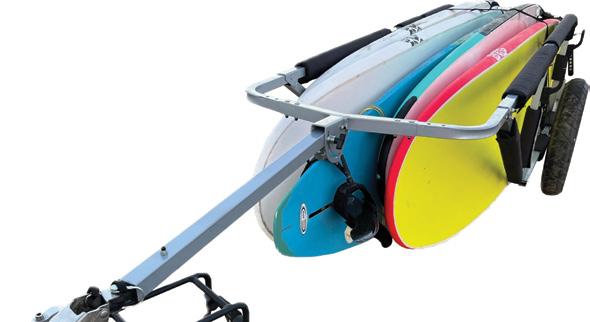


The Moved By Bikes (MBB) Paddleboard and Kayak Trailer is a practical and reliable solution for transporting kayaks, paddleboards, or multiple surfboards to the beach. Built with a durable, lightweight frame, it handles various terrains well and attaches easily to your bike with a secure hitch system. Fully adjustable in both length and width, the trailer can accommodate different sizes and shapes of watercraft. It also folds for compact storage when not in use. Using this trailer to transport large boards or kayaks by bike is especially advantageous during the busy high season when traffic and parking at popular beaches can be a nightmare. The MBB Paddleboard and Kayak Trailer is a great choice for outdoor enthusiasts looking for an efficient and ecofriendly way to get to their favorite surf or paddle spot.
MSRP: $665.00 • movedbybikes.com
The Astal Indus revolutionizes whitewater and swiftwater rescue safety with its innovative FoamTectonics™ design, offering 22 lbs of flotation. It’s the world’s first high-float life jacket inspired by freestyle design and crafted for dynamic environments. Designed for durability and precision, the Indus PFD combines exceptional buoyancy with unrestricted mobility. Its FoamTectonics™ architecture molds seamlessly to the body, ensuring a secure fit crucial for swiftwater and whitewater activities. Beyond flotation, the Indus integrates practical features for whitewater rescue professionals and enthusiasts. Strategic pockets provide easy access to tools, reflective accents enhance visibility, and a ventilated back enhances comfort during intense use.
Astal prioritizes sustainability with PVCfree Gaia® foam and bluesign® approved fabrics, minimizing environmental impact while maintaining durability and performance. For professionals and enthusiasts navigating swift currents or engaged in rescue operations, the Astal Indus PFD sets a new standard in
whitewater safety and comfort.
MSRP: $375.00 • astraldesigns.com
The LEKI ULTRATRAIL FX.ONE running poles are crafted for trail runners seeking lightweight yet durable performance gear. Made from carbon, these poles strike a balance between strength and agility, ideal for navigating diverse terrains. The ergonomic Aergon Thermo foam grips with Trail Shark design ensure a comfortable and secure hold, even during extended use or in challenging conditions. Key to their versatility is the Speed Lock+ adjustment system, which allows for swift and precise length adjustments on the fly, enhancing stability and confidence on rugged trails. The integrated carbide flex tips with baskets further contribute to stability, providing reliable traction on rocky, uneven surfaces. The collapsible design makes these poles highly portable. Whether you’re a novice or a seasoned trail runner, these poles are designed to elevate your trail running experience.
MSRP: $219.95 • lekiusa.com


The Helinox Chair Zero High Back is a premium ultralight camping chair designed for backpackers and outdoor enthusiasts seeking both portability and comfort. Weighing only 1 lb 8 oz, it features a high backrest that provides enhanced support compared to the original Chair Zero, which weighs 1 lb. Constructed with durable DAC aluminum alloy and polyester ripstop fabric, it offers a robust build without sacrificing lightness. Despite its minimal weight, the chair can support up to 265 lbs and packs down compactly, ensuring easy transport. While the original Chair Zero is ideal for those prioritizing minimal weight, the High Back version is perfect for those who want to pack light but still desire a comfortable place to sit and relax after a long day.
MSRP: $179.95 • helinox.com
The Arc’teryx Cerium Hybrid Hoody offers an excellent warmth-to-weight ratio, making it ideal for activities like hiking, climbing, or simply staying warm during cooler weather outings. The Cerium Hybrid Hoody features a thoughtful combination of 850 fill power down and Coreloft™ synthetic insulation. The high-quality down provides warmth and compressibility, making it perfect for maintaining comfort during chilly mornings or cool evenings. The Coreloft™ synthetic insulation is strategically placed in moisture-prone areas such as the hood, cuffs, and underarms, ensuring that the jacket retains its insulating properties even in damp conditions.
Crafted from Arato™ 15 fabric, this jacket

is both lightweight and durable. The fabric’s DWR (durable water repellent) finish offers additional protection against light rain and snow, though the jacket is not fully waterproof. The Cerium Hybrid Hoody’s trim fit provides a streamlined silhouette, allowing it to layer comfortably under a shell without adding bulk. One of the jacket’s key advantages is its packability. It can be compressed into its own internal zippered security pocket, making it easy to stow in a backpack when not in use. This feature is particularly useful for those who need a reliable and easily transportable insulation layer.
MSRP: Men’s $350.00 - Women’s $300.00 • arcteryx.com
The EXPED Widget Pump is a compact device designed to inflate various items quickly. It includes a Universal Valve Adapter for versatility and features two inflation modes: a fast mode and a quieter mode suitable for late-night use. With a rechargeable lithium battery and a USB-C port for quick recharging, the Widget Pump is both efficient and convenient. Weighing just 6.7 ounces, this pump is highly portable and fits easily into any backpack. In addition to its pumping capabilities, this device doubles as a bright camping lamp with three light levels. Furthermore, it serves as a 3600 mAh power bank, enhancing its versatility. The Widget Pump is user-friendly with straightforward controls and clear instructions. Whether you’re inflating sleeping pads, illuminating your campsite, or charging devices, the EXPED Widget Pump delivers on all fronts.
MSRP: $49.95 • expedusa.com


